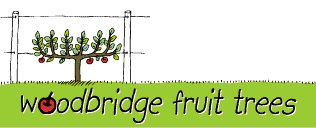No products
 View larger
View larger
Spanish bush pruning
by Bob Magnus | © 2006 Woodbridge Fruit Trees | www.woodbridgefruittrees.com.au

The northern coast of Spain on the Bay of Biscay has a mild moist climate quite similar to southern Australia and Tasmania. Most of Spain’s dairies and apple orchards are here. There’s also a surprisingly large amount of eucalyptus trees (mostly E. Globulus). In the province of Asturias in the middle of the Atlantic coast are most of Spain’s cherry orchards and it’s from this area that the 'Spanish Bush' training method originated. This is a training method in which the vigour of the tree is spread over many branches rather than a main trunk, and the aim is to produce a bush form (above) rather than that of a tree.

fig 1. After planting, prune the baby tree back to 30cm above the graft.

fig 2. At the end of the first growing season (Year 1) you should have something that looks like this.
This allows for all the fruit to be harvested from the ground rather than from a ladder and it keeps the cherry trees to an easily managed size, easily covered with nets or fruit cages against birds (if you don’t cover cherries, don’t even bother planting them - the birds will get the lot).
At a planting distance of 2 metres apart, one aims at producing a bush with about 20 - 30 leaders. Cherries produce fruit on spurs and these spurs are viable for many years, so once the bush shape is formed, there is minimal pruning. Actually the main pruning consists of cutting (with a saw) right down at the base, the most vigorous branches that grow too tall to be harvested from the ground.

fig 3. At the beginning of year 2, repeat the pruning process; that is, prune all the leaders 30cm above the original cuts. (This may hurt a bit as there will be some blossom but you’ll still get some cherries further down on the main trunk)

fig 4. At the beginning of year 3, repeat the pruning process yet again 30cm above the previous years cuts and again 'the bush' will react by putting out lots of small branches rather than big thick ones. Any big thick suckers should be removed right down where they originate. By the end of season 3, there should be from 15 to 25 leaders.
Henceforth keep removing the most vigorous branches low down on the tree scaffold. Where this branch is removed, 2 or 3 more will grow in its place. These will form spurs and produce fruit in their second year. The trees (bushes) can be maintained indefinitely by this method and very heavy crops of fruits produced. The secret is to form the bush shape early and keep removing the tallest most vigorous branches. Once you’ve tried these new cherries: Lapins, Stellas, Simone and Sunburst - you’ll be hooked forever! Your diligence will be amply repaid.
The spanish bush method works well for apples too, just as cherries can be espaliered just as easily as apples (see my article on apple espaliers - you can treat apples and cherries in the same manner), just like you can apply this system to apples. Of course, whatever growing method you use, don’t compromise on tree care - that is, adequate water and fertilizer (but not too much!), a weed free zone around each tree and in the case of cherries, watch out for cherry slug on the leaves (a pyrethrum spray will fix it). If you don’t control cherry slug, they will defoliate and weaken the trees.
by Bob Magnus | © 2006 Woodbridge Fruit Trees | www.woodbridgefruittrees.com.au

The northern coast of Spain on the Bay of Biscay has a mild moist climate quite similar to southern Australia and Tasmania. Most of Spain’s dairies and apple orchards are here. There’s also a surprisingly large amount of eucalyptus trees (mostly E. Globulus). In the province of Asturias in the middle of the Atlantic coast are most of Spain’s cherry orchards and it’s from this area that the 'Spanish Bush' training method originated. This is a training method in which the vigour of the tree is spread over many branches rather than a main trunk, and the aim is to produce a bush form (above) rather than that of a tree.

fig 1. After planting, prune the baby tree back to 30cm above the graft.

fig 2. At the end of the first growing season (Year 1) you should have something that looks like this.
This allows for all the fruit to be harvested from the ground rather than from a ladder and it keeps the cherry trees to an easily managed size, easily covered with nets or fruit cages against birds (if you don’t cover cherries, don’t even bother planting them - the birds will get the lot).
At a planting distance of 2 metres apart, one aims at producing a bush with about 20 - 30 leaders. Cherries produce fruit on spurs and these spurs are viable for many years, so once the bush shape is formed, there is minimal pruning. Actually the main pruning consists of cutting (with a saw) right down at the base, the most vigorous branches that grow too tall to be harvested from the ground.

fig 3. At the beginning of year 2, repeat the pruning process; that is, prune all the leaders 30cm above the original cuts. (This may hurt a bit as there will be some blossom but you’ll still get some cherries further down on the main trunk)

fig 4. At the beginning of year 3, repeat the pruning process yet again 30cm above the previous years cuts and again 'the bush' will react by putting out lots of small branches rather than big thick ones. Any big thick suckers should be removed right down where they originate. By the end of season 3, there should be from 15 to 25 leaders.
Henceforth keep removing the most vigorous branches low down on the tree scaffold. Where this branch is removed, 2 or 3 more will grow in its place. These will form spurs and produce fruit in their second year. The trees (bushes) can be maintained indefinitely by this method and very heavy crops of fruits produced. The secret is to form the bush shape early and keep removing the tallest most vigorous branches. Once you’ve tried these new cherries: Lapins, Stellas, Simone and Sunburst - you’ll be hooked forever! Your diligence will be amply repaid.
The spanish bush method works well for apples too, just as cherries can be espaliered just as easily as apples (see my article on apple espaliers - you can treat apples and cherries in the same manner), just like you can apply this system to apples. Of course, whatever growing method you use, don’t compromise on tree care - that is, adequate water and fertilizer (but not too much!), a weed free zone around each tree and in the case of cherries, watch out for cherry slug on the leaves (a pyrethrum spray will fix it). If you don’t control cherry slug, they will defoliate and weaken the trees.
Reviews
No customer reviews for the moment.

